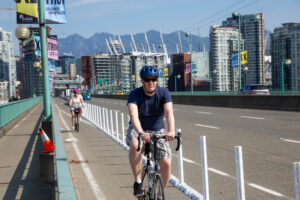Vancouver is becoming as well-known for its cycling culture as it is for its rain. But what happens when the two intersect? Yes, slick roads and cold, wet commutes are part of it. But just because it’s raining doesn’t mean you have to lock up your bike for the season.
We have an extensive network of bike lanes and thousands are commuting by bike every day. Biking in the cold Vancouver rain does require some changes in the way you prepare and cycle. Here are five quick tips to keep you safe in the rain.
Dress for the rain
Being cold and damp is neither fun nor comfortable. Wear waterproof clothing and footwear to keep dry and wick any wet off you. Use a light backpack or a pannier (or bike basket) to carry a change of clothing and keep something on hand in case the weather changes. While they can cover you in a pinch, do be cautious when using a rain poncho – keep them clear of your gears and chain so they don’t snag and suddenly seize up your bike.
Light up your way
Make sure you have a bright white light for your bike or helmet. In Vancouver, it’s the law. The light does two very important things. First, it helps with your visibility. Rain can reduce your ability to see and it gets worse if it is dark or foggy. Second, a light lets pedestrians, drivers, and cyclists see you.
Slippery when wet
You should always plan out your route but if you’re a daily bike commuter, you probably have the same route every day. On drier days, take note of the surfaces you’re biking on. Things like grates, manhole covers, and painted markings all become slick when wet. Know where they are on your route and adjust your speed when you approach them.
Cycling over the rainbows
You know those little rainbow-hued patches that pop up on pavement when the rain starts to fall? That’s oil and gas residue from the asphalt and passing cars. They can be very slippery so keep an eye out to avoid hard braking when you’re cycling through them.
Maintain your bike
Keep your bike maintained and in good working order. That means checking brake pads and brake lines, making sure reflectors and lights are working and clear of dirt, and that the chain is well-oiled. Also, slightly deflate your tires. This will extend the width of the tire, giving it more surface contact and greater grip on the road.
For more information
- Metro Vancouver bike commuters geared up for the rain, Vancouver Sun
- Helpful Information About Cycling in Metro Vancouver, HUB Cycling
- Cycling in Vancouver, City of Vancouver






